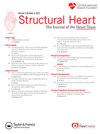采用经导管球囊膨胀阀治疗单纯主动脉反流的新技术:一项概念验证研究
IF 1.4
Q3 CARDIAC & CARDIOVASCULAR SYSTEMS
引用次数: 0
摘要
背景:本研究的目的是评估一种假设,即在单纯主动脉反流的患者中,采用“向外流动脉扩张”技术可能允许经导管球囊可膨胀瓣膜(bev)锚定。方法本研究为单中心、6例患者、连续、回顾性观察队列研究。单纯AR不能手术的患者纳入经导管主动脉瓣植入术。该技术涉及部署具有2毫米超大尺寸的bev和“耀斑流出”技术。在基线和植入后进行计算机断层扫描。结果所有患者均成功植入外排管。所有患者出院时均无器械移位,无或无瓣旁漏。在1年的随访中,没有观察到死亡、瓣膜功能障碍或再干预。在随访的6例患者中,有5例患者接受了计算机断层扫描,结果证实bev的流出量与环空相比过度扩张,平均(24.5 vs. 23.3 mm, p = 0.02)和最小直径(24.6 vs. 22.2 mm, p = 0.01)。结论应用bev结合“闪光流出”技术在不能手术的纯AR患者中证明了可行性和有效性。需要进一步的研究来确定该技术的耐久性和终身管理。本文章由计算机程序翻译,如有差异,请以英文原文为准。
Novel Technique Employing Transcatheter Balloon-Expandable Valves in Pure Aortic Regurgitation: A Proof-of-Concept Study
Background
The aim of this study was to evaluate the hypothesis that employing the “flare the outflow” technique might allow anchoring of transcatheter balloon-expandable valves (BEVs) in patients with pure aortic regurgitation.
Methods
This was a single-center, 6-patient, consecutive, retrospective observational cohort. Inoperable patients with pure AR were included to perform transcatheter aortic valve implantation. The technique involved deploying BEVs with 2-mm oversizing and “flare the outflow” technique. Computed tomography scans were obtained at baseline and after implantation.
Results
BEVs with the flared outflow were successfully implanted in all patients. All patients were discharged without device migration and none or trace paravalvular leak. At 1-year follow-up, no deaths, valve dysfunction, or reinterventions were observed. Among the 5 patients out of 6 who underwent follow-up computed tomography scans, findings confirmed the overexpanded outflow of the BEVs compared to the annulus, indicated by mean (24.5 vs. 23.3 mm, p = 0.02) and minimal diameters (24.6 vs. 22.2 mm, p = 0.01).
Conclusions
The utilization of BEVs incorporating the “flare the outflow” technique demonstrated feasibility and effectiveness in inoperable patients with pure AR. Further studies are required to determine the durability and lifetime management associated with this technique.
求助全文
通过发布文献求助,成功后即可免费获取论文全文。
去求助
来源期刊

Structural Heart
Medicine-Cardiology and Cardiovascular Medicine
CiteScore
1.60
自引率
0.00%
发文量
81
 求助内容:
求助内容: 应助结果提醒方式:
应助结果提醒方式:


